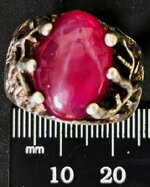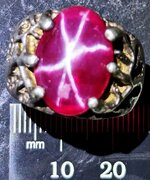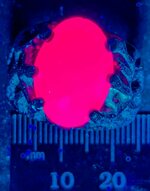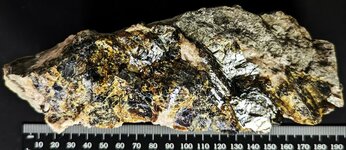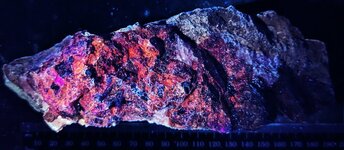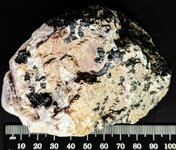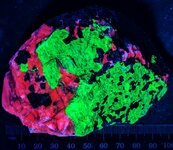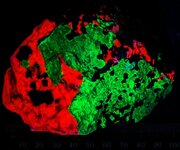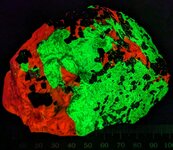Stephanie Blandin and KingTotsalot made a run over to the Memphis Agri-Complex to see the 2024 Memphis Club’s Rock, Gem & Mineral Show. It is about a 3.5 hour drive from Little Rock, AR, and we decided to forego lunch until we had spent our time looking around. Since KT am not interested in jewelry or beads and such, He managed to scope out all the pertinent dealers in a little over 1.5 hours. He saw lots of fluorescent minerals, but few specimens in His Royal price range (under $20) that I did not have. Some mineral dealers even had a table of nothing but fluorescent specimens! Getting pretty popular KT thinks.
Stephanie moves a bit slower than KT and as a lady is interested in jewelry and loose cut stones, so she took an addition 40 minutes to peruse the tables, which was fine with KT as He sat in the Royal Coach in the shade and took a nap until she called and said I am headed to the entrance.
At one booth His Majesty found a tray with 6 large flat ruby crystals, marked $12 each. Checking with the Royal LW lamp, 2 crystals had superior red fluorescence, so they were purchased. No location given, but from the size and crystallization, KT knew they were from the Mysore Corundum Deposits in Karnatakah State, India. There are a couple of pictures on Mindat.org that have this flat hexagonal form, with triangular stepped growths on the C pinacoid face and a touch of black biotite associated, like these crystals. First picture shows the natural light color as a purplish red, and the second picture shows the strong red response to LW 365nm. No response to MW or SW.
After looking at several booths with over priced fluorescents that KT already has in the Royal collection, He came across a dealer’s table with 5 pieces of “Zebra” Stromatolite. Knowing that stromatolites often fluoresce, KT put the Royal LW lamp on it and it had a nice yellow-orange striped response. It was the only piece not priced, typical, and the dealer gave KT a price of $10, so it was purchased. It came with a decent label. There are 3 pictures of this specimen, the first being in natural light, the second in LW 365nm, and the third in MW 310nm. No response to SW.
After leaving the show, both Stephanie and KT were hungry for seafood, which we found in abundance at the King Krab bistro, a small hole in the wall cafe specializing in an amazing assortment of seafood, cajun and otherwise! After eating our fill, we drove over to Forrest City, Arkansas, filled up with fuel, and headed back to the Castle by way of the old Memphis Highway 70.
A good time was had by all!
Enjoy the pictures!
Stephanie moves a bit slower than KT and as a lady is interested in jewelry and loose cut stones, so she took an addition 40 minutes to peruse the tables, which was fine with KT as He sat in the Royal Coach in the shade and took a nap until she called and said I am headed to the entrance.
At one booth His Majesty found a tray with 6 large flat ruby crystals, marked $12 each. Checking with the Royal LW lamp, 2 crystals had superior red fluorescence, so they were purchased. No location given, but from the size and crystallization, KT knew they were from the Mysore Corundum Deposits in Karnatakah State, India. There are a couple of pictures on Mindat.org that have this flat hexagonal form, with triangular stepped growths on the C pinacoid face and a touch of black biotite associated, like these crystals. First picture shows the natural light color as a purplish red, and the second picture shows the strong red response to LW 365nm. No response to MW or SW.
After looking at several booths with over priced fluorescents that KT already has in the Royal collection, He came across a dealer’s table with 5 pieces of “Zebra” Stromatolite. Knowing that stromatolites often fluoresce, KT put the Royal LW lamp on it and it had a nice yellow-orange striped response. It was the only piece not priced, typical, and the dealer gave KT a price of $10, so it was purchased. It came with a decent label. There are 3 pictures of this specimen, the first being in natural light, the second in LW 365nm, and the third in MW 310nm. No response to SW.
After leaving the show, both Stephanie and KT were hungry for seafood, which we found in abundance at the King Krab bistro, a small hole in the wall cafe specializing in an amazing assortment of seafood, cajun and otherwise! After eating our fill, we drove over to Forrest City, Arkansas, filled up with fuel, and headed back to the Castle by way of the old Memphis Highway 70.
A good time was had by all!
Enjoy the pictures!
Attachments
-
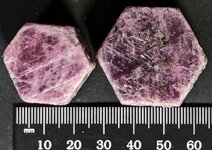 Corundum, var. Ruby, Mysore Corundum Deposit, Karnatakan State, India, natural light.jpg145.5 KB · Views: 4
Corundum, var. Ruby, Mysore Corundum Deposit, Karnatakan State, India, natural light.jpg145.5 KB · Views: 4 -
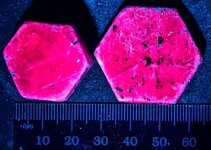 Corundum, var. Ruby, Mysore Corundum Deposit, Karnatakan State, India, LW 365nm.jpg152.5 KB · Views: 5
Corundum, var. Ruby, Mysore Corundum Deposit, Karnatakan State, India, LW 365nm.jpg152.5 KB · Views: 5 -
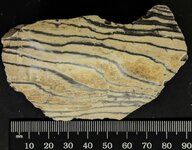 Stromatolite, Zebra, Middle Eocene, Green River Fm., Tipton Shale Mbr., Cedar Mountain, Park C...jpg129.9 KB · Views: 5
Stromatolite, Zebra, Middle Eocene, Green River Fm., Tipton Shale Mbr., Cedar Mountain, Park C...jpg129.9 KB · Views: 5 -
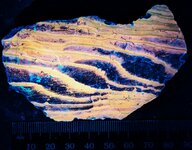 Stromatolite, Zebra, Middle Eocene, Green River Fm., Tipton Shale Mbr., Cedar Mountain, Park C...jpg148.8 KB · Views: 7
Stromatolite, Zebra, Middle Eocene, Green River Fm., Tipton Shale Mbr., Cedar Mountain, Park C...jpg148.8 KB · Views: 7 -
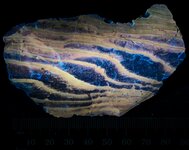 Stromatolite, Zebra, Middle Eocene, Green River Fm., Tipton Shale Mbr., Cedar Mountain, Park C...jpg110.3 KB · Views: 5
Stromatolite, Zebra, Middle Eocene, Green River Fm., Tipton Shale Mbr., Cedar Mountain, Park C...jpg110.3 KB · Views: 5


